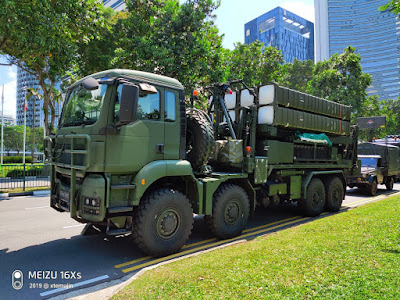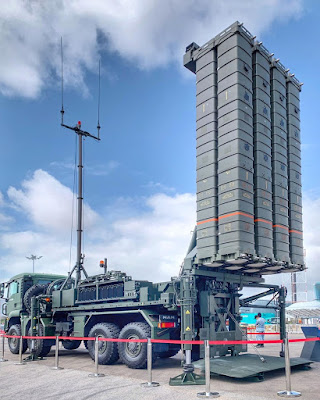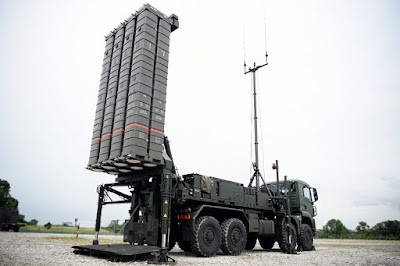Aster-30 SAMP/T (Surface-to-Air Missile Platform/Terrain) of the RSAF (image : RSAF)
Aster 30 SAMP/T: What’s the hype about
The national day parade (NDP) this year showcased the Republic of Singapore Air Force (RSAF) latest surface to air missile (SAM) platform, the European MBDA Aster-30. The RSAF is extremely excited about the new system, albeit an identity gaffe by the local Straits Times and Newpaper, and introduced to replace the current I-HAWK operated by 163 Sqn. But what’s all the hype about these missiles?
To understand why the Aster-30 is revolutionary, one has to understand how air defence and the threats to air defence have changed over the years.
Lessons from countless air conflicts showed how Western air arms were able to defeat dense air defence installations with suppression of enemy air defence (SEAD) capabilities, destroying SAM-radar systems with standoff weapons rendering the SAM useless. These missiles, together with jammers, are increasingly available to nations worldwide.
Aster-30 SAMP/T of the RSAF (photo : xtemujin)
There has since been a proliferation of rockets worldwide, be it from the armed forces or non-state actors assembling home-made systems. Traditional SAM systems like the I-HAWK are not able to tackle these munitions flying across the skies. Such threats were seen to great effect in the Middle East, in Saudi Arabia and Israel, and closer to home, Singapore had a scare when radicals plotted to launch homemade rockets from Batam island.
Planes are getting faster, radar cross-sections smaller, and tactics have also emerged to ensure mass coordinated attacks from various directions to confuse enemy air defences. New SAM missiles have to tackle these new threats.
The Aster 30, was initially designed for naval use but was re-designed by MBDA for land-based requirements. The official designation is the Aster-30SAMP/T (Surface-to-Air Missile Platform/Terrain) with Aster named after the Greek archer Asterion.
Aster-30 SAMP/T of the RSAF (photo : Lowyat)
The predecessor I-HAWK is a bulky monster, the three large missiles can only fire up to around 40km (depending on altitude), and requires around 5-6 men with a truck to tow and deploy the system. The self-propelled Aster30, with eight missiles mounted on the 8-wheeled MAN-truck, allows three men to erect the system in 15 minutes, a manpower saving of around 90% and ratio increase of missiles per missile battery of 260% (3vs8).
With a range of 70km, its gives Air Defence and Operation Command (ADOC) the flexibility to engage any high-value targets at a greater standoff range, ensuring these platforms itself do not have the opportunity to lob any standoff/munitions addressed in issue 1. The range also gives RSAF fighters the liberty to push ahead further, to operate at a greater distance from the island.
Even if there are any incoming missiles/munitions, the Aster is now able to engage any known flying objects, thanks to a network of high-resolution radar that can detect, track and lock on to small and fast-moving targets.
Aster-30 SAMP/T of the RSAF (photo : Picuki)
The beauty of the RSAF air defence network is the Island Air Defence (IAD) system, locally developed to meet our needs. Think of it as a massive jailbreak for radar and missile system where now ‘Apple OS’ and communicate with ‘Andriod’ and ‘Windows OS’. Our myriad of radar systems and missiles types are able to be linked with the civilian radar system and thus giving the ADOC a full common recognised air situation picture across all missile site and C2 centres.
As mentioned, SAMs sites can be prone to SEAD actions and easily defeated once its radar sites are taken out, IAD prevents that since the missiles are fed by over six radar types in the IAD stable, from the long-range FPS-117, to the high-resolution ELM-2084, designed to track and engage missiles. Defence watchers will note that our Aster-30 package does not come with additional radars, something which is common in systems in other sates.
Aster-30 SAMP/T of the RSAF (photo : Mindef)
The Aster 30 can now engage several targets simultaneously, addressing issue 3. The system can offload all eight missiles in 10 seconds, and one can imagine how many it can engage if the Aster is deployed en masse. Since it is a vertical launch, it can engage virtually at 360 degrees without spending time to swerve its missile towards the direction of the target. Also at Mach 4, a single Aster 30 battery would have engaged all eight targets at 70km, just when one I-HAWK missile just hits its target at 40km.
As air threats evolve, the RSAF’s layered umbrella air defence have changed as well. Gone were the days where the I-HAWK, Rapier, RBS70 and 35mm Oerlikon gun distinct segmented layers. Today, the interlinked systems and flexible missile systems meant that the layers are pretty much blurred, overlapping each other for a enhance air defence dome, and the Aster 30 with its cousins from other 160-series squadrons will bring the ADOC to a new chapter in ground based air defence.
(Coffee n Bullets)




